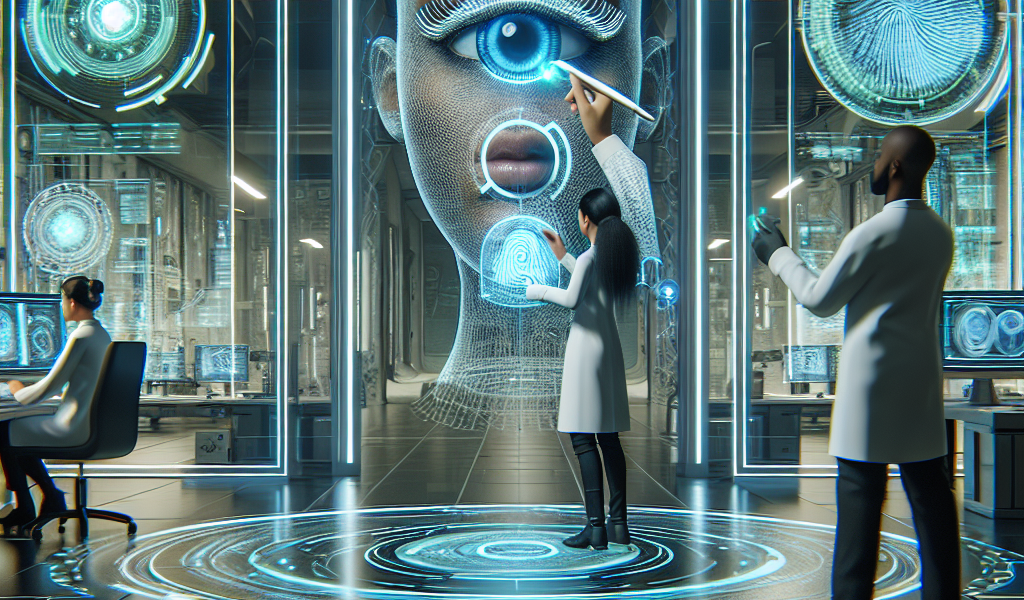-
Table of Contents
“Unlocking Tomorrow: The Future of Biometric Technology”
Introduction

The future of biometric technology promises to revolutionize the way we authenticate identity, secure data, and interact with digital systems. As advancements in artificial intelligence, machine learning, and sensor technology continue to accelerate, biometric systems are becoming more accurate, reliable, and versatile. From fingerprint and facial recognition to more sophisticated modalities like iris scanning, voice recognition, and even behavioral biometrics, these technologies are poised to enhance security protocols across various sectors, including finance, healthcare, and law enforcement. The integration of biometrics into everyday devices and applications will not only streamline user experiences but also provide robust protection against identity theft and fraud. However, as biometric technology evolves, it also raises critical questions about privacy, data security, and ethical use, necessitating comprehensive regulatory frameworks to ensure responsible deployment.
Advances In Biometric Authentication Methods
Biometric technology has come a long way since its inception, evolving from simple fingerprint recognition to sophisticated systems capable of identifying individuals through a myriad of unique biological traits. As we look to the future, advances in biometric authentication methods promise to revolutionize the way we secure our digital and physical worlds. This transformation is driven by the need for more secure, efficient, and user-friendly authentication solutions in an increasingly interconnected society.
One of the most significant advancements in biometric technology is the development of facial recognition systems. These systems have become more accurate and reliable, thanks to improvements in machine learning algorithms and the availability of large datasets for training. Facial recognition is now being used in various applications, from unlocking smartphones to enhancing security at airports and public events. The technology’s ability to quickly and accurately identify individuals has made it a popular choice for both security and convenience.
In addition to facial recognition, iris scanning has emerged as a highly secure biometric authentication method. The unique patterns in an individual’s iris provide a level of accuracy that is difficult to replicate or spoof. Iris scanning is already being used in high-security environments, such as government buildings and financial institutions, where the need for robust security measures is paramount. As the technology becomes more affordable and accessible, it is likely to see wider adoption in everyday applications.
Voice recognition is another area where significant progress has been made. Advances in natural language processing and artificial intelligence have enabled the development of voice recognition systems that can accurately identify individuals based on their unique vocal characteristics. This technology is being integrated into virtual assistants, customer service systems, and secure access controls, offering a hands-free and convenient authentication method. The ability to authenticate users through their voice adds an extra layer of security, particularly in scenarios where traditional methods may be impractical.
Moreover, behavioral biometrics is an emerging field that focuses on identifying individuals based on their unique patterns of behavior. This includes factors such as typing rhythm, mouse movements, and even walking gait. By continuously monitoring these behaviors, systems can detect anomalies that may indicate unauthorized access or fraudulent activity. Behavioral biometrics offers a dynamic and adaptive approach to security, complementing traditional static methods and providing a more comprehensive defense against threats.
As biometric technology continues to advance, privacy and ethical considerations become increasingly important. The collection and storage of biometric data raise concerns about potential misuse and the need for robust data protection measures. Ensuring that biometric systems are designed with privacy in mind and comply with relevant regulations is crucial to maintaining public trust and acceptance.
Furthermore, the integration of multiple biometric modalities, known as multimodal biometrics, is gaining traction. By combining different biometric traits, such as fingerprints, facial recognition, and voice recognition, systems can achieve higher accuracy and reliability. Multimodal biometrics also provide a fallback mechanism in case one modality fails or is compromised, enhancing overall security.
In conclusion, the future of biometric technology is bright, with continuous advancements paving the way for more secure and user-friendly authentication methods. From facial recognition and iris scanning to voice recognition and behavioral biometrics, these innovations are set to transform the way we protect our digital and physical assets. As we embrace these technologies, it is essential to address privacy and ethical concerns to ensure their responsible and widespread adoption. The journey towards a more secure future is well underway, and biometric technology is at the forefront of this exciting evolution.
The Role Of Biometric Technology In Enhancing Security
Biometric technology has rapidly evolved over the past few decades, becoming an integral part of our daily lives. From unlocking smartphones with a fingerprint to passing through airport security with facial recognition, the applications of biometrics are vast and varied. As we look to the future, the role of biometric technology in enhancing security is poised to expand even further, promising to revolutionize the way we protect our personal information and secure our environments.
One of the most significant advantages of biometric technology is its ability to provide a higher level of security compared to traditional methods such as passwords or PINs. Biometric identifiers, such as fingerprints, iris patterns, and facial features, are unique to each individual, making them extremely difficult to replicate or forge. This inherent uniqueness ensures that biometric systems can offer a more reliable and robust form of authentication, reducing the risk of unauthorized access.
Moreover, the convenience of biometric technology cannot be overstated. In an age where time is of the essence, the ability to quickly and effortlessly verify one’s identity is invaluable. For instance, consider the growing use of facial recognition technology at airports. By streamlining the boarding process, passengers can move through security checkpoints more efficiently, reducing wait times and enhancing the overall travel experience. This seamless integration of security and convenience is a testament to the potential of biometric technology to transform various aspects of our lives.
In addition to personal convenience, biometric technology also plays a crucial role in safeguarding sensitive information. As cyber threats continue to evolve, the need for robust security measures has never been more critical. Biometric authentication can provide an additional layer of protection for online accounts and digital transactions, making it more challenging for cybercriminals to gain unauthorized access. For example, many financial institutions are now incorporating biometric verification into their mobile banking apps, ensuring that only the account holder can perform transactions.
Furthermore, the use of biometric technology extends beyond individual security to encompass broader societal applications. Law enforcement agencies, for instance, have increasingly adopted biometric systems to aid in criminal investigations. Fingerprint databases and facial recognition software can help identify suspects and solve cases more efficiently, ultimately contributing to public safety. However, it is essential to balance these benefits with concerns about privacy and ethical considerations. Ensuring that biometric data is collected, stored, and used responsibly is paramount to maintaining public trust and preventing potential misuse.
As we look ahead, the future of biometric technology appears promising, with ongoing advancements poised to enhance its capabilities further. Emerging technologies such as voice recognition and behavioral biometrics are gaining traction, offering new avenues for secure authentication. Voice recognition, for example, can analyze unique vocal patterns to verify identity, while behavioral biometrics can assess an individual’s unique patterns of behavior, such as typing rhythm or gait, to provide an additional layer of security.
In conclusion, the role of biometric technology in enhancing security is multifaceted and ever-evolving. Its ability to offer a higher level of security, coupled with the convenience it provides, makes it an invaluable tool in our increasingly digital world. As we continue to innovate and refine these technologies, it is crucial to address privacy concerns and ensure responsible use. By doing so, we can harness the full potential of biometric technology to create a safer and more secure future for all.
Ethical Considerations And Privacy Concerns In Biometric Data Usage
As biometric technology continues to advance at a rapid pace, it is becoming increasingly integrated into our daily lives. From unlocking smartphones with a fingerprint to airport security systems that use facial recognition, the convenience and security offered by biometric data are undeniable. However, as with any technological advancement, the rise of biometric data usage brings with it a host of ethical considerations and privacy concerns that must be addressed.
One of the primary ethical concerns surrounding biometric technology is the potential for misuse of personal data. Biometric data, by its very nature, is deeply personal and unique to each individual. Unlike passwords or PINs, which can be changed if compromised, biometric data is immutable. This raises significant concerns about what happens if such data falls into the wrong hands. For instance, if a database containing biometric information is hacked, the consequences could be far more severe than a traditional data breach. The permanence of biometric data means that once it is compromised, it cannot be easily replaced or reset.
Moreover, the collection and storage of biometric data also raise questions about consent and transparency. Many users may not fully understand the extent to which their biometric data is being collected, stored, and used. This lack of transparency can lead to a sense of unease and mistrust among the public. It is crucial for companies and organizations that utilize biometric technology to be upfront about their data collection practices and to obtain explicit consent from users. This not only helps to build trust but also ensures that individuals are making informed decisions about their personal data.
In addition to concerns about data security and consent, there are also broader ethical implications to consider. For example, the use of biometric technology in surveillance can lead to issues of discrimination and bias. Facial recognition systems, in particular, have been shown to have higher error rates for people of color and women. This can result in unfair treatment and reinforce existing societal biases. It is essential for developers of biometric technology to address these biases and work towards creating more equitable systems.
Furthermore, the widespread use of biometric technology can also lead to a loss of anonymity. In a world where our faces, fingerprints, and even our voices can be used to identify us, the concept of privacy becomes increasingly elusive. This has significant implications for personal freedom and autonomy. Individuals may feel constantly monitored and surveilled, leading to a chilling effect on free expression and behavior.
Despite these concerns, it is important to recognize the potential benefits of biometric technology. When used responsibly and ethically, biometric data can enhance security, streamline processes, and improve user experiences. For instance, biometric authentication can provide a higher level of security than traditional methods, reducing the risk of fraud and identity theft. Additionally, biometric technology can offer greater convenience, allowing for seamless and efficient interactions in various contexts.
To navigate the ethical landscape of biometric technology, it is essential for stakeholders, including policymakers, developers, and users, to engage in ongoing dialogue and collaboration. Establishing clear guidelines and regulations can help to ensure that biometric data is used responsibly and that individuals’ rights are protected. By addressing ethical considerations and privacy concerns head-on, we can harness the potential of biometric technology while safeguarding the values that underpin our society.
Conclusion
The future of biometric technology is poised for significant advancements, driven by increasing demand for enhanced security and convenience. Innovations in areas such as facial recognition, fingerprint scanning, and iris recognition are expected to become more accurate and widespread, integrating seamlessly into everyday devices and systems. As privacy concerns and ethical considerations are addressed, biometric technology will likely play a crucial role in various sectors, including finance, healthcare, and law enforcement, ultimately transforming how identity verification and access control are managed globally.





